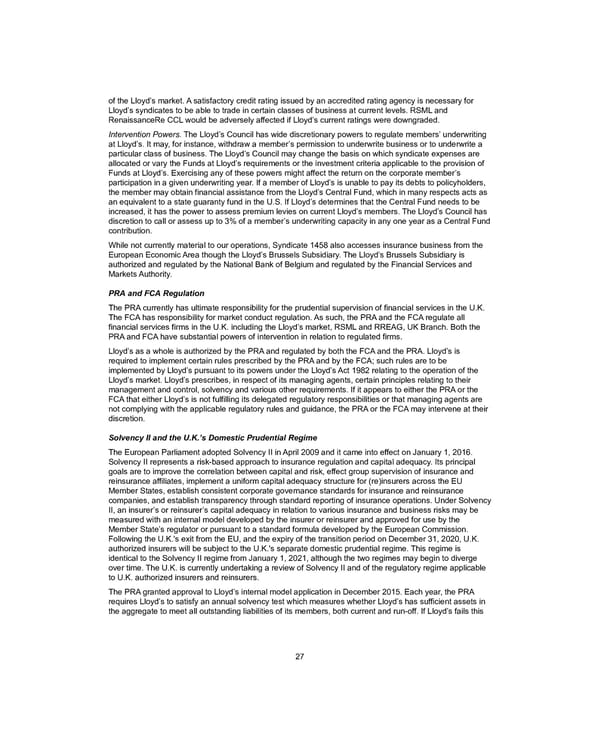of the Lloyd’s market. A satisfactory credit rating issued by an accredited rating agency is necessary for Lloyd’s syndicates to be able to trade in certain classes of business at current levels. RSML and RenaissanceRe CCL would be adversely affected if Lloyd’s current ratings were downgraded. Intervention Powers . The Lloyd’s Council has wide discretionary powers to regulate members’ underwriting at Lloyd’s. It may, for instance, withdraw a member’s permission to underwrite business or to underwrite a particular class of business. The Lloyd’s Council may change the basis on which syndicate expenses are allocated or vary the Funds at Lloyd’s requirements or the investment criteria applicable to the provision of Funds at Lloyd’s. Exercising any of these powers might affect the return on the corporate member’s participation in a given underwriting year. If a member of Lloyd’s is unable to pay its debts to policyholders, the member may obtain financial assistance from the Lloyd’s Central Fund, which in many respects acts as an equivalent to a state guaranty fund in the U.S. If Lloyd’s determines that the Central Fund needs to be increased, it has the power to assess premium levies on current Lloyd’s members. The Lloyd’s Council has discretion to call or assess up to 3% of a member’s underwriting capacity in any one year as a Central Fund contribution. While not currently material to our operations, Syndicate 1458 also accesses insurance business from the European Economic Area though the Lloyd’s Brussels Subsidiary. The Lloyd’s Brussels Subsidiary is authorized and regulated by the National Bank of Belgium and regulated by the Financial Services and Markets Authority. PRA and FCA Regulation The PRA currently has ultimate responsibility for the prudential supervision of financial services in the U.K. The FCA has responsibility for market conduct regulation. As such, the PRA and the FCA regulate all financial services firms in the U.K. including the Lloyd’s market, RSML and RREAG, UK Branch. Both the PRA and FCA have substantial powers of intervention in relation to regulated firms. Lloyd’s as a whole is authorized by the PRA and regulated by both the FCA and the PRA. Lloyd’s is required to implement certain rules prescribed by the PRA and by the FCA; such rules are to be implemented by Lloyd’s pursuant to its powers under the Lloyd’s Act 1982 relating to the operation of the Lloyd’s market. Lloyd’s prescribes, in respect of its managing agents, certain principles relating to their management and control, solvency and various other requirements. If it appears to either the PRA or the FCA that either Lloyd’s is not fulfilling its delegated regulatory responsibilities or that managing agents are not complying with the applicable regulatory rules and guidance, the PRA or the FCA may intervene at their discretion. Solvency II and the U.K.’s Domestic Prudential Regime The European Parliament adopted Solvency II in April 2009 and it came into effect on January 1, 2016. Solvency II represents a risk-based approach to insurance regulation and capital adequacy. Its principal goals are to improve the correlation between capital and risk, effect group supervision of insurance and reinsurance affiliates, implement a uniform capital adequacy structure for (re)insurers across the EU Member States, establish consistent corporate governance standards for insurance and reinsurance companies, and establish transparency through standard reporting of insurance operations. Under Solvency II, an insurer’s or reinsurer’s capital adequacy in relation to various insurance and business risks may be measured with an internal model developed by the insurer or reinsurer and approved for use by the Member State’s regulator or pursuant to a standard formula developed by the European Commission. Following the U.K.'s exit from the EU, and the expiry of the transition period on December 31, 2020, U.K. authorized insurers will be subject to the U.K.'s separate domestic prudential regime. This regime is identical to the Solvency II regime from January 1, 2021, although the two regimes may begin to diverge over time. The U.K. is currently undertaking a review of Solvency II and of the regulatory regime applicable to U.K. authorized insurers and reinsurers. The PRA granted approval to Lloyd’s internal model application in December 2015. Each year, the PRA requires Lloyd’s to satisfy an annual solvency test which measures whether Lloyd’s has sufficient assets in the aggregate to meet all outstanding liabilities of its members, both current and run-off. If Lloyd’s fails this 27
 2021 Annual Report Page 42 Page 44
2021 Annual Report Page 42 Page 44